2017年中考英语二轮语法专题复习课件之非谓语动词
文档属性
| 名称 | 2017年中考英语二轮语法专题复习课件之非谓语动词 |  | |
| 格式 | zip | ||
| 文件大小 | 141.3KB | ||
| 资源类型 | 教案 | ||
| 版本资源 | 通用版 | ||
| 科目 | 英语 | ||
| 更新时间 | 2017-01-07 22:03:26 | ||
图片预览


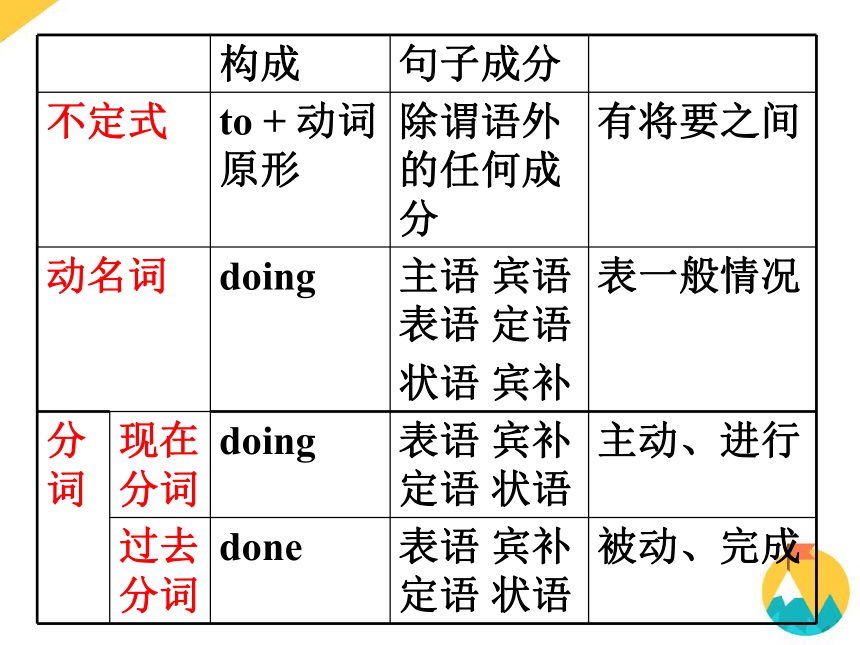


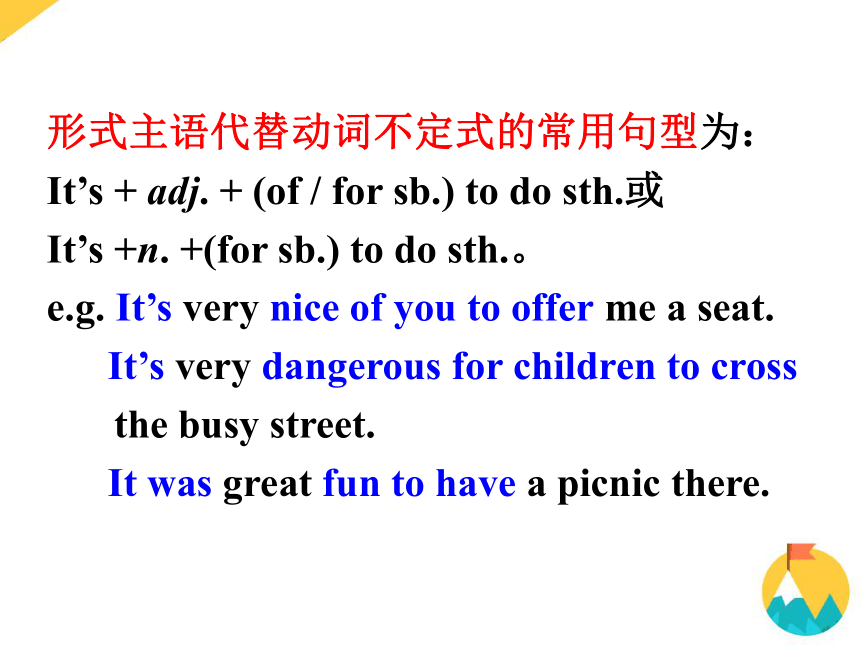


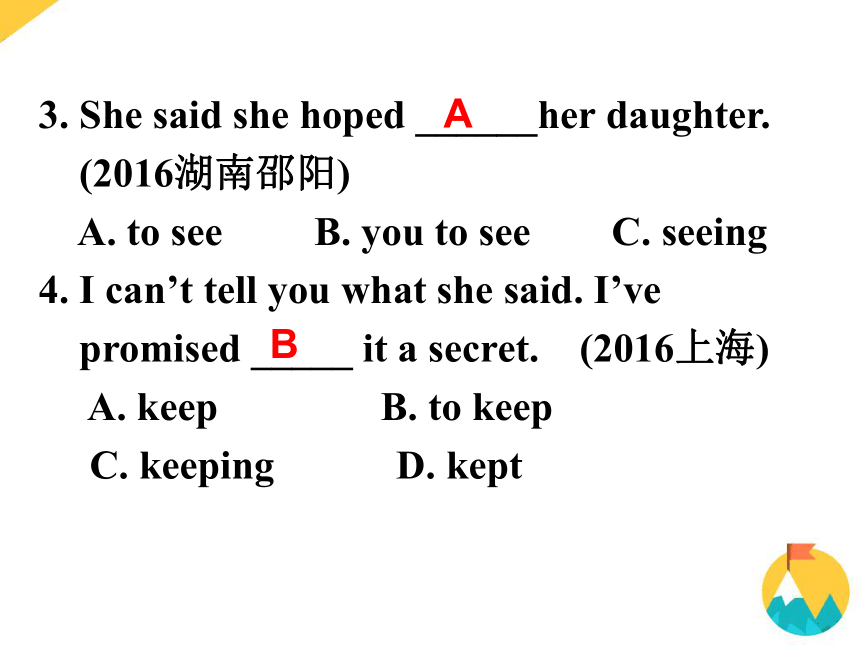
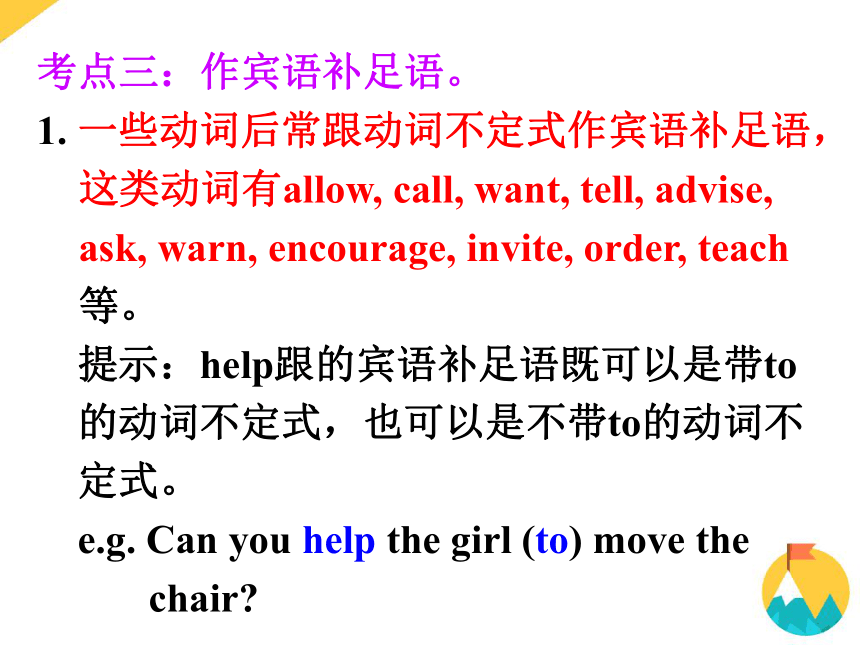
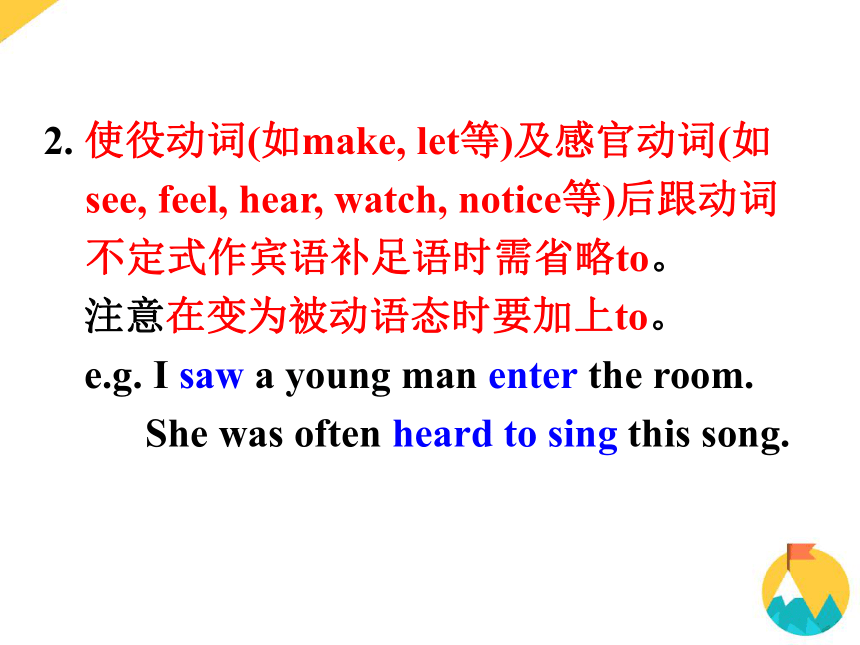
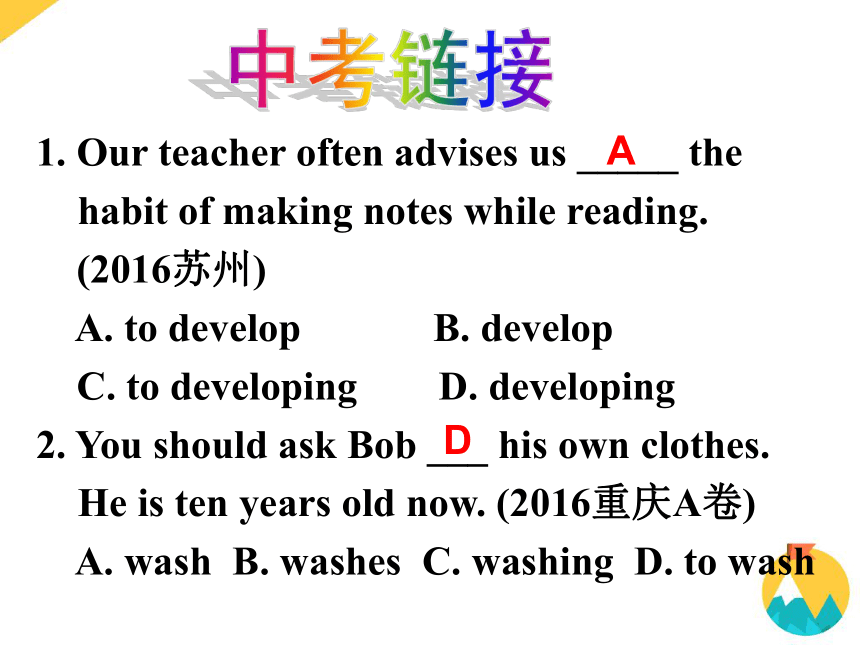
文档简介
课件38张PPT。非谓语动词非谓语动词包括动词不定式、动名词和分词三种,其中分词包括现在分词和过去分词。非谓语动词在句中不能单独作谓语,不受主语的人称和数的限制。
非谓语动词既有动词性质(比如可以有自己的宾语、状语等),又有非动词性质(比如动名词相当于名词;分词相当于形容词和副词;不定式相当于名词、形容词和副词等)。 动词不定式
动词不定式可以在句中作宾语、宾语补足语和目的状语等。
动词不定式由“to+动词原形”构成,有时to可以省略。动词不定式没有人称和数的变化,其否定形式为“not+动词不定式”。 e.g. To learn English well is difficult.
动词不定式作主语时,为了保持句子平衡,常用it代替它作形式主语,而将真正的主语——动词不定式后置,上面的例句常写为:It’s difficult to learn English well.考点一:作主语。形式主语代替动词不定式的常用句型为:
It’s + adj. + (of / for sb.) to do sth.或
It’s +n. +(for sb.) to do sth.。
e.g. It’s very nice of you to offer me a seat.
It’s very dangerous for children to cross the busy street.
It was great fun to have a picnic there.考点二:作宾语。
常跟动词不定式作宾语的动词有agree, afford, decide, determine, expect, fail, hope, learn, offer, prepare, plan, promise, refuse, want等。
注意:在find,?think等后跟动词不定式作宾语时,常用it作形式宾语,而将真正的宾语——动词不定式后置。
e.g. I?find?it?hard?to?get?along?with?him.? 1. They decided _____ a bridge over the river. (2015四川遂宁)
A. build B. to build C. building
2. I?wanted?to?see?the?Beijing?Opera,?so?
Lingling?offered?____?me?to?watch?an?
opera.?????(2016天津)
A. took?????????? B. takes???????????????????
C. to?take????????? D. taking中考链接BC 3. She?said?she?hoped?______her?daughter.??
(2016湖南邵阳)
A. to?see?????????B. you?to?see????????C. seeing
4. I?can’t?tell?you?what?she?said.?I’ve?
promised?_____?it?a?secret.????(2016上海)?
A. keep??????????? B. to?keep?????????????
C. keeping????????????D. kept??A B 考点三:作宾语补足语。
1.?一些动词后常跟动词不定式作宾语补足语,这类动词有allow, call, want, tell, advise, ask, warn, encourage, invite, order, teach等。
提示:help跟的宾语补足语既可以是带to
的动词不定式,也可以是不带to的动词不
定式。
e.g. Can you help the girl (to) move the
chair?2.?使役动词(如make, let等)及感官动词(如see, feel, hear, watch, notice等)后跟动词不定式作宾语补足语时需省略to。
注意在变为被动语态时要加上to。
e.g. I saw a young man enter the room.
She was often heard to sing this song.1. Our teacher often advises us _____ the habit of making notes while reading.
(2016苏州)?
A.?to develop? B.?develop??
C.?to?developing? D.?developing
2. You?should?ask?Bob?___?his?own?clothes. He is ten years old now. (2016重庆A卷)
A. wash B. washes C. washing D. to wash A 中考链接D 3. We?advise?parents?______?their?children?
at?home?alone?in?order?to?keep?them?
away??from?danger. (2016黑龙江东)
A.?not?to?leave????????
B.?not?leave????????????
C.?not?leaving?A 考点四:作定语。
动词不定式可以作名词的定语;还可在某些句型中作定语,与所修饰的名词是动宾关系。
e.g. I haven’t had the chance to think yet.
(作名词的定语)
提示:动词不定式作定语修饰名词且为动宾关系时,如果动词为不及物动词,后面要加上相应的介词。
e.g. Tina?has?no?paper?to?write?on.?? Joining?a?summer?camp?is?a?great chance?____?free?time?with?your?friends.?
(2016吉林)
A. spend B. spending C. to spend C 中考链接考点四:?作状语。
动词不定式作状语往往表示原因、目的、结
果等。
e.g. They were surprised to find that nobody was in the house.? (表示原因)
To get a good seat she arrived at the hall early. ?(表示目的)
The boy is old enough to take care of himself. ?(表示结果) 说明:
1. had better,?would rather,?Why not ...?,Will / Would you please ...?后面接不带to的动词不定式。
e.g. To catch the early bus, you’d better
get up early tomorrow morning.
2.?动词不定式可以和疑问词what,?which,?how,where,?when等连用,构成动词不定式的特殊结构。
e.g. Can you tell me where to buy a map?1. —?I’ll have a ten-day holiday. But I don’t
know ______.??
—?How about Paris?? (2016成都)?
A. what to do? B.?where to go
C.?when to goB 中考链接2. The?Chinese?team?are?working?hard
?____ honors?in?the?2016 Olympic?Games.???
(2016湖南株洲)
A. to?win??????? ?B. win?????????????C. winning?
3. It’s?getting?dark.?You’d?better?_____
out?by?yourself.?It’s?dangerous. (2016四川宜宾)
A. not?go????????B. not?to?go?????????????C. to?go?A A 4. I?bought?a?big?box?________?books?
for?kids?in?poor?areas.?? (2016吉林长春)
A.?collects??? B.?to?collect???
C.?collect???? D.?collected B 动词-ing形式
动词的-ing形式由“动词原形+-ing”构成,其否定形式为“not+动词的-ing形式”。
动词的-ing形式在句中可以作主语、宾语、表语、定语、宾语补足语等。 考点一:作主语。
动名词作主语和动词不定式作主语,在很多情况下可以通用。
e.g. Playing / To play computer games too
much is bad for your eyes. Our English teacher often says to us, “_____ English well is very important.”
(2013四川内江)
A. Learn B. Learning
C. Learned D. To learning中考链接B 考点二:作宾语。
1. 在初中阶段我们需要掌握的后跟动词-ing形式作宾语的词语有dislike, consider, enjoy, finish, imagine, keep, mind, practice, suggest, give up, put off, keep on, be busy, have fun, be afraid of, be good at, be interested in, be used to, look forward to, feel like, thanks for等。 2.?有些及物动词(如like,?love,?hate,?
begin,?start等)既可以跟动词的-ing形式作宾语,也可以跟动词不定式作宾语,且意思上没什么差别。如:
e.g. Do you like reading / to read? 3.?有些及物动词(如remember,?
forget,?stop,?try等)既可以跟动词的-ing形式作宾语,也可以跟动词不定式作宾语,但意义有别。 1.?We?feel?like?_____?some?food?and?drink?because?we’ll?invite?some?friends _____ in?a?party. (2016黑龙江齐齐哈尔)
A. buying,?to?join???
B. to?buy,?joining???????????
C. buying,?join?中考链接A 2. After?she?finished?______the?story,?
Alice?wrote?a?review?for?her?school?
newspaper.? (2016上海)
A. read??????????? B. reads???????????????????
C. to?read??????? D. reading
3. Bruce?practices?________?basketball?
every?day?so?that?he?can?be?a?better?
player.? (2016海南)
A.?play??????????B.?to?play????????????C.?playing D C 4. My?father?used?to?drive?to?work,?but?he?is?
used?to?______?now.? (2016贵州六盘水)
A. walking?????????? B. walked??????????????
C. walks???????????? D. walkA 考点三:宾语补足语
一些动词既可以接动词不定式又可接动词-ing形式,作宾语补足语的有区别。
感官动词(如see,watch,notice,hear,feel等)?后既可跟不带to的动词不定式作宾语补足语,也可以跟动词-ing形式作宾语补足语。前者表示动作的全过程,后者表示动作正在进行。 1. The?show?was so?funny?that?it?made?
everyone ______ again and again. (2016山东济宁)
A. laugh B. laughed
C. laughing D. to laugh? C 中考链接2. I heard Tom _____ when I walked past his room yesterday. (2015江苏宿迁)
A. sing B. singing
C. to sing D. sang
3. I saw some boy students _____ basketball
when I passed the playground. (2014贵州
安顺)
A. played B. plays
C. playing D. to playA C 考点四:作定语。
e.g. The man standing there is my friend Look! There are some birds _____ in the sky. They are very beautiful. (2015四川宜宾)
A. to fly B. fly
C. flying D. flown中考链接C 分词
分词分为现在分词和过去分词两种。
现在分词(v. -ing)有主动、进行之意;
过去分词(v. -ed)有被动、完成之意。 在语态上,现在分词表示主动,过去分词表示被动。
在时间上,现在分词表示正在进行的动作,过去分词表示已经完成的动作。 考点一:作定语。
e.g. China is a developing country.
America is a developed country.
考点二:作表语。
e.g. The book is interesting. I’m
interested in it. 考点三:作宾语补足语。
e.g. I saw her going upstairs.
I want to have some photos taken.
考点四:作状语。
e.g. Laughing and talking, they went into
the room.
非谓语动词既有动词性质(比如可以有自己的宾语、状语等),又有非动词性质(比如动名词相当于名词;分词相当于形容词和副词;不定式相当于名词、形容词和副词等)。 动词不定式
动词不定式可以在句中作宾语、宾语补足语和目的状语等。
动词不定式由“to+动词原形”构成,有时to可以省略。动词不定式没有人称和数的变化,其否定形式为“not+动词不定式”。 e.g. To learn English well is difficult.
动词不定式作主语时,为了保持句子平衡,常用it代替它作形式主语,而将真正的主语——动词不定式后置,上面的例句常写为:It’s difficult to learn English well.考点一:作主语。形式主语代替动词不定式的常用句型为:
It’s + adj. + (of / for sb.) to do sth.或
It’s +n. +(for sb.) to do sth.。
e.g. It’s very nice of you to offer me a seat.
It’s very dangerous for children to cross the busy street.
It was great fun to have a picnic there.考点二:作宾语。
常跟动词不定式作宾语的动词有agree, afford, decide, determine, expect, fail, hope, learn, offer, prepare, plan, promise, refuse, want等。
注意:在find,?think等后跟动词不定式作宾语时,常用it作形式宾语,而将真正的宾语——动词不定式后置。
e.g. I?find?it?hard?to?get?along?with?him.? 1. They decided _____ a bridge over the river. (2015四川遂宁)
A. build B. to build C. building
2. I?wanted?to?see?the?Beijing?Opera,?so?
Lingling?offered?____?me?to?watch?an?
opera.?????(2016天津)
A. took?????????? B. takes???????????????????
C. to?take????????? D. taking中考链接BC 3. She?said?she?hoped?______her?daughter.??
(2016湖南邵阳)
A. to?see?????????B. you?to?see????????C. seeing
4. I?can’t?tell?you?what?she?said.?I’ve?
promised?_____?it?a?secret.????(2016上海)?
A. keep??????????? B. to?keep?????????????
C. keeping????????????D. kept??A B 考点三:作宾语补足语。
1.?一些动词后常跟动词不定式作宾语补足语,这类动词有allow, call, want, tell, advise, ask, warn, encourage, invite, order, teach等。
提示:help跟的宾语补足语既可以是带to
的动词不定式,也可以是不带to的动词不
定式。
e.g. Can you help the girl (to) move the
chair?2.?使役动词(如make, let等)及感官动词(如see, feel, hear, watch, notice等)后跟动词不定式作宾语补足语时需省略to。
注意在变为被动语态时要加上to。
e.g. I saw a young man enter the room.
She was often heard to sing this song.1. Our teacher often advises us _____ the habit of making notes while reading.
(2016苏州)?
A.?to develop? B.?develop??
C.?to?developing? D.?developing
2. You?should?ask?Bob?___?his?own?clothes. He is ten years old now. (2016重庆A卷)
A. wash B. washes C. washing D. to wash A 中考链接D 3. We?advise?parents?______?their?children?
at?home?alone?in?order?to?keep?them?
away??from?danger. (2016黑龙江东)
A.?not?to?leave????????
B.?not?leave????????????
C.?not?leaving?A 考点四:作定语。
动词不定式可以作名词的定语;还可在某些句型中作定语,与所修饰的名词是动宾关系。
e.g. I haven’t had the chance to think yet.
(作名词的定语)
提示:动词不定式作定语修饰名词且为动宾关系时,如果动词为不及物动词,后面要加上相应的介词。
e.g. Tina?has?no?paper?to?write?on.?? Joining?a?summer?camp?is?a?great chance?____?free?time?with?your?friends.?
(2016吉林)
A. spend B. spending C. to spend C 中考链接考点四:?作状语。
动词不定式作状语往往表示原因、目的、结
果等。
e.g. They were surprised to find that nobody was in the house.? (表示原因)
To get a good seat she arrived at the hall early. ?(表示目的)
The boy is old enough to take care of himself. ?(表示结果) 说明:
1. had better,?would rather,?Why not ...?,Will / Would you please ...?后面接不带to的动词不定式。
e.g. To catch the early bus, you’d better
get up early tomorrow morning.
2.?动词不定式可以和疑问词what,?which,?how,where,?when等连用,构成动词不定式的特殊结构。
e.g. Can you tell me where to buy a map?1. —?I’ll have a ten-day holiday. But I don’t
know ______.??
—?How about Paris?? (2016成都)?
A. what to do? B.?where to go
C.?when to goB 中考链接2. The?Chinese?team?are?working?hard
?____ honors?in?the?2016 Olympic?Games.???
(2016湖南株洲)
A. to?win??????? ?B. win?????????????C. winning?
3. It’s?getting?dark.?You’d?better?_____
out?by?yourself.?It’s?dangerous. (2016四川宜宾)
A. not?go????????B. not?to?go?????????????C. to?go?A A 4. I?bought?a?big?box?________?books?
for?kids?in?poor?areas.?? (2016吉林长春)
A.?collects??? B.?to?collect???
C.?collect???? D.?collected B 动词-ing形式
动词的-ing形式由“动词原形+-ing”构成,其否定形式为“not+动词的-ing形式”。
动词的-ing形式在句中可以作主语、宾语、表语、定语、宾语补足语等。 考点一:作主语。
动名词作主语和动词不定式作主语,在很多情况下可以通用。
e.g. Playing / To play computer games too
much is bad for your eyes. Our English teacher often says to us, “_____ English well is very important.”
(2013四川内江)
A. Learn B. Learning
C. Learned D. To learning中考链接B 考点二:作宾语。
1. 在初中阶段我们需要掌握的后跟动词-ing形式作宾语的词语有dislike, consider, enjoy, finish, imagine, keep, mind, practice, suggest, give up, put off, keep on, be busy, have fun, be afraid of, be good at, be interested in, be used to, look forward to, feel like, thanks for等。 2.?有些及物动词(如like,?love,?hate,?
begin,?start等)既可以跟动词的-ing形式作宾语,也可以跟动词不定式作宾语,且意思上没什么差别。如:
e.g. Do you like reading / to read? 3.?有些及物动词(如remember,?
forget,?stop,?try等)既可以跟动词的-ing形式作宾语,也可以跟动词不定式作宾语,但意义有别。 1.?We?feel?like?_____?some?food?and?drink?because?we’ll?invite?some?friends _____ in?a?party. (2016黑龙江齐齐哈尔)
A. buying,?to?join???
B. to?buy,?joining???????????
C. buying,?join?中考链接A 2. After?she?finished?______the?story,?
Alice?wrote?a?review?for?her?school?
newspaper.? (2016上海)
A. read??????????? B. reads???????????????????
C. to?read??????? D. reading
3. Bruce?practices?________?basketball?
every?day?so?that?he?can?be?a?better?
player.? (2016海南)
A.?play??????????B.?to?play????????????C.?playing D C 4. My?father?used?to?drive?to?work,?but?he?is?
used?to?______?now.? (2016贵州六盘水)
A. walking?????????? B. walked??????????????
C. walks???????????? D. walkA 考点三:宾语补足语
一些动词既可以接动词不定式又可接动词-ing形式,作宾语补足语的有区别。
感官动词(如see,watch,notice,hear,feel等)?后既可跟不带to的动词不定式作宾语补足语,也可以跟动词-ing形式作宾语补足语。前者表示动作的全过程,后者表示动作正在进行。 1. The?show?was so?funny?that?it?made?
everyone ______ again and again. (2016山东济宁)
A. laugh B. laughed
C. laughing D. to laugh? C 中考链接2. I heard Tom _____ when I walked past his room yesterday. (2015江苏宿迁)
A. sing B. singing
C. to sing D. sang
3. I saw some boy students _____ basketball
when I passed the playground. (2014贵州
安顺)
A. played B. plays
C. playing D. to playA C 考点四:作定语。
e.g. The man standing there is my friend Look! There are some birds _____ in the sky. They are very beautiful. (2015四川宜宾)
A. to fly B. fly
C. flying D. flown中考链接C 分词
分词分为现在分词和过去分词两种。
现在分词(v. -ing)有主动、进行之意;
过去分词(v. -ed)有被动、完成之意。 在语态上,现在分词表示主动,过去分词表示被动。
在时间上,现在分词表示正在进行的动作,过去分词表示已经完成的动作。 考点一:作定语。
e.g. China is a developing country.
America is a developed country.
考点二:作表语。
e.g. The book is interesting. I’m
interested in it. 考点三:作宾语补足语。
e.g. I saw her going upstairs.
I want to have some photos taken.
考点四:作状语。
e.g. Laughing and talking, they went into
the room.
同课章节目录
- 词法
- 名词
- 动词和动词短语
- 动词语态
- 动词时态
- 助动词和情态动词
- 非谓语动词
- 冠词
- 代词
- 数词和量词
- 形容词副词及其比较等级
- 介词和介词短语
- 连词和感叹词
- 构词法
- 相似、相近词比较
- 句法
- 陈述句
- 一般疑问句和否定疑问句
- 特殊疑问句及选择疑问句
- 反意疑问句
- 存在句(There be句型)
- 宾语从句
- 定语从句
- 状语从句
- 主谓一致问题
- 简单句
- 并列句
- 复合句
- 主谓一致
- 主、表语从句
- 名词性从句
- 直接引语和间接引语
- 虚拟语气
- 感叹句
- 强调句
- 倒装句
- 祈使句
- 句子的成分
- 句子的分类
- 题型专区
- 单项选择部分
- 易错题
- 完形填空
- 阅读理解
- 词汇练习
- 听说训练
- 句型转换
- 补全对话
- 短文改错
- 翻译
- 书面表达
- 任务型阅读
- 语法填空
- 其他资料
